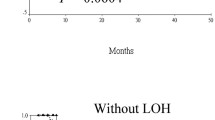Abstract
Multiple somatic and inherited genetic changes that lead to loss of growth control may contribute to the development of breast cancer. Microsatellites are tandem repeats of simple sequences that occur abundantly and at random throughout most eucaryotic genomes. Microsatellite instability (MI), characterized by the presence of random contractions or expansions in the length of simple sequence repeats or microsatellites, is observed in a variety of tumors. The aim of this study was to compare tumor DNA fingerprints with constitutional DNA fingerprints to investigate changes specific to breast cancer and evaluate its correlation with clinical characteristics. Tumor and normal tissue samples of 38 patients with breast cancer were investigated by comparing PCR-amplified microsatellite sequences D2S443 and D21S1436. Microsatellite instability at D21S1436 and D2S443 was found in 5 (13%) and 7 (18%) patients, respectively. Two patients displayed instability at both marker loci. No association was found between MI and age, family history, lymph node involvement and other clinical parameters.
Similar content being viewed by others
References
Dickson RB, Lippman ME. Molecular basis of breast cancer. In: The Molecular Basis of Cancer, WB Saunders, 358–384, 1995.
Hovig E, Smith-Sorensen B, Uitterlinden AG, et al: Detection of DNA variation in cancer. Pharmacogenetics 2:317–328, 1992.
Paulson TG, Wright FA, Parker BA, et al: Microsatellite instability correlates with reduced survival and poor disease prognosis in breast cancer. Cancer Res 56:4021–4026, 1996.
Ali S, Müller CR, Epplen JT. DNA fingerprinting by oligonucleotide probes specific for simple repeats. Hum Genet 74:239–243, 1986.
Decker RA, Moore J, Ponder B, et al: Linkage mapping of human chromosome 10 microsatellite polymorphisms. Genomics 12:604–606, 1992.
Weber JL, Wong C. Mutation of human short tandem repeats. Hum Mol Genet 2:1123–1128, 1993.
Branch P, Aquilina G, Bignami M, et al: Defective mismatch binding and a mutator phenotype in cells tolerant to DNA damage. Nature 362:652–654, 1993.
Fey MF, Wells RA, Wainscoat JS, et al: Assessment of clonality in gastrointestinal cancer by DNA fingerprinting. J Clin Invest 82:1532–1537, 1988.
Jeffreys AJ, Neumann R, Wilson V. Repeat unit sequence variation in minisatellites: A novel source of DNA polymorphism for studying variation and mutation by single molecule analysis. Cell 60:473–485, 1990.
Samowitz WS, Curtin K, Ma KN, et al: Microsatellite instability in sporadic colon cancre is associated with an improved prognosis at the population level. Cancer Epidem Biomarkers Prev 10:917–923, 2001.
van Rhijn BWG, Lurkin I, Kirkels WJ, et al: Microsatellite analysis — DNA test in urine competes with cystoscopy in follow-up of superficial bladder carcinoma. Cancer 92:768–775, 2001.
Han HJ, Yanagisawa A, Kato Y, et al: Genetic instability in pancreatic cancer and poorly differentiated type of gastric cancer. Cancer Res 53:5087–5089, 1993.
Gonzalez R, Silva JM, Sanchez A, et al: Microsatellite alterations and TP53 mutations in plasma DNA of small cell lung cancer patients: Follow-up study and prognostic significance. Annals Oncol 11:1097–1104, 2000.
Contegiacomo A, Palmirotta R, De Marchis L, et al: Microsatellite instability and pathological aspects of breast cancer. Int J Cancer 64:264–268, 1995.
Vaurs-Barriere C, Penault-Llorca F, Laplace-Marieze V, et al: Low frequency of microsatellite instability in BRCA1 mutated breast tumors. J Med Genet 37:1–3, 2000.
Chen P, Hurst T, Khoo SK. Detection of somatic DNA alterations in ovarian cancer by DNA fingerprint analysis. Cancer 67:1551–1555, 1991.
Fearon ER, Vogelstein B. Tumor suppressor and DNA repair gene defects in human cancer. In : Holland JF, Bast RC, Morton DL, Frei III E, Kufe DW Weichselbaum RR (eds). Cancer Medicine. 4. ed. Williams and Wilkins, 97–119, 1997.
Alexander J, Watanabe T, Wu TT, et al: Histopathological identification of colon cancer with microsatellite instability. Am J Pathol 158:527–535, 2001.
Seripa D, Parrella P, Gallucci M, et al: Sensitive detection of transitional cell carcinoma of the bladder by microsatellite analysis of cells exfoliated in urine. Int J Cancer 95:364–369, 2001.
Rha SH, Dong SM, Jen J, et al. Molecular detection of cervical intraepithelial neoplasia and cervical carcinoma by microsatellite analysis of Papanicolaou smears. Int J Cancer 93:424–429, 2001.
Gonzalez-Zulueta M, Ruppert JM, et al: Microsatellite instability in bladder cancer. Cancer Res 53:5620–5623, 1993.
Sourvinos G, Kiaris H, Tsikkinis A, et al: Microsatellite instability and loss of heterozygosity in primary breast tumors. Tumor Biol 18:157–166, 1997.
Thibodeau SN, Bren G, Schaid D. Microsatellite instability in cancer of the proximal colon. Science 260:816–819, 1993.
Rush EB, Calvano JE, Van Zee KJ, et al: Microsatellite instability in breast cancer. Ann Surg Oncol 4:310–315, 1997.
Shaw JA, Walsh T, Chappell SA, et al: Microsatellite instability in early sporadic breast cancer. Br J Cancer 73:1393–1397, 1996.
Kasami M, Vnencak-Jones CL, Manning S, et al: Loss of heterozygosity and microsatellite instability in breast hyperplasia. Am J Pathol 150:1925–1931, 1997.
Krajinovic M, Richer C, Gorska-Flipot I, et al: Genomic loci susceptible to replication errors in cancer cells. Br J Cancer 78:981–985, 1998.
Author information
Authors and Affiliations
Corresponding author
Rights and permissions
About this article
Cite this article
Demokan, S., Muslumanoglu, M., Yazici, H. et al. Investigation of microsatellite instability in Turkish breast cancer patients. Pathol. Oncol. Res. 8, 138–141 (2002). https://doi.org/10.1007/BF03033724
Received:
Accepted:
Issue Date:
DOI: https://doi.org/10.1007/BF03033724




